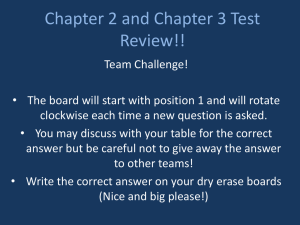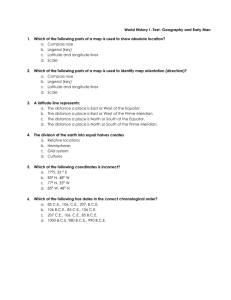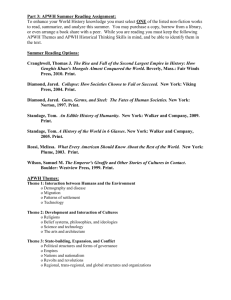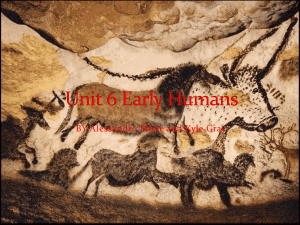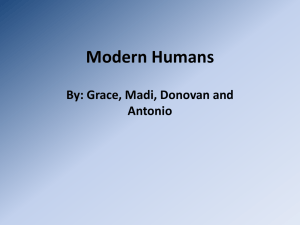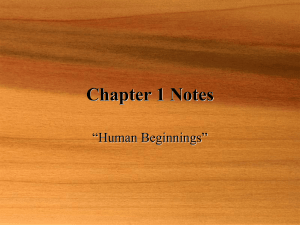APWH U1: Chart 1.1 – Prehistoric to Neolithic Last: First: Quaide
advertisement
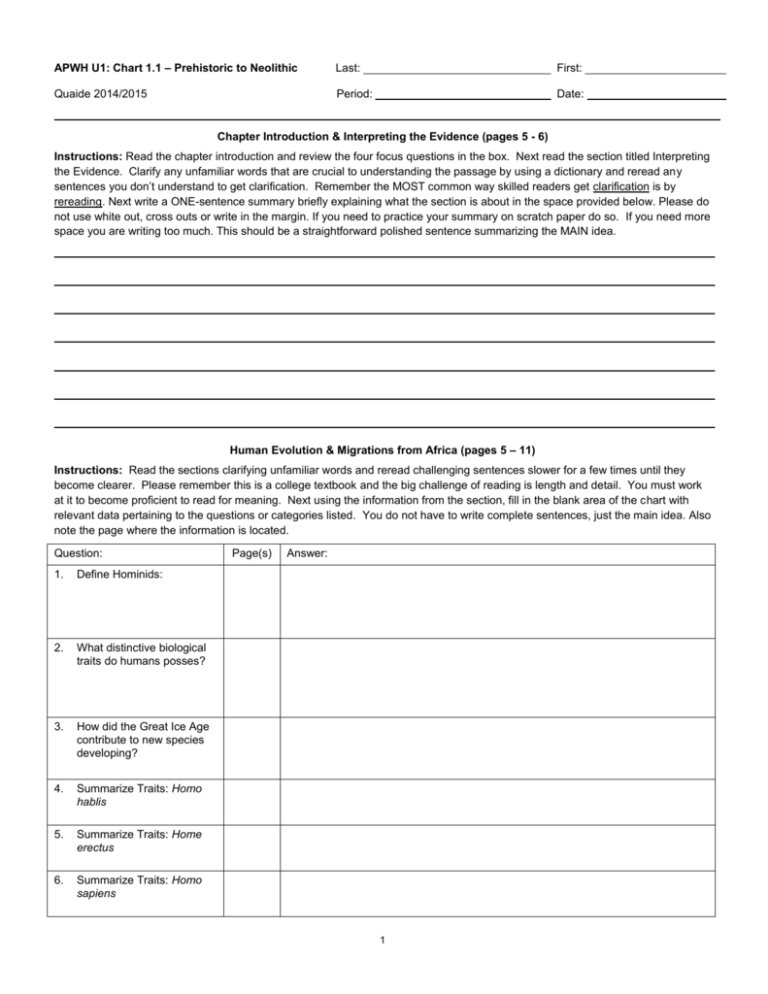
APWH U1: Chart 1.1 – Prehistoric to Neolithic Last: First: Quaide 2014/2015 Period: Date: Chapter Introduction & Interpreting the Evidence (pages 5 - 6) Instructions: Read the chapter introduction and review the four focus questions in the box. Next read the section titled Interpreting the Evidence. Clarify any unfamiliar words that are crucial to understanding the passage by using a dictionary and reread any sentences you don’t understand to get clarification. Remember the MOST common way skilled readers get clarification is by rereading. Next write a ONE-sentence summary briefly explaining what the section is about in the space provided below. Please do not use white out, cross outs or write in the margin. If you need to practice your summary on scratch paper do so. If you need more space you are writing too much. This should be a straightforward polished sentence summarizing the MAIN idea. Human Evolution & Migrations from Africa (pages 5 – 11) Instructions: Read the sections clarifying unfamiliar words and reread challenging sentences slower for a few times until they become clearer. Please remember this is a college textbook and the big challenge of reading is length and detail. You must work at it to become proficient to read for meaning. Next using the information from the section, fill in the blank area of the chart with relevant data pertaining to the questions or categories listed. You do not have to write complete sentences, just the main idea. Also note the page where the information is located. Question: 1. Define Hominids: 2. What distinctive biological traits do humans posses? 3. How did the Great Ice Age contribute to new species developing? 4. Summarize Traits: Homo hablis 5. Summarize Traits: Home erectus 6. Summarize Traits: Homo sapiens Page(s) Answer: 1 7. Describe Homo Erectus migration 8. Describe Homo sapiens migration 9. What evolutionary change did Homo sapiens undergo? Technology & Culture in the Ice Age (pages 11 - 16) Instructions: Define the terms listed & then complete the chart with relevant data pertaining to the categories listed. (Not all blank areas will necessarily be equally complete) Define Culture: Culture Includes: Define Stone Age: Define Paleolithic: Define Neolithic: Define Foragers: 2 FOOD GATHERING & TECHNOLOGY (STONE TOOLS) 3. 4. Role of technology: a. What did Homo hablis, Homo erectus, & Homo sapiens develop for hunting & food (meat) preparation? What did Hunter-Gather diet consist of? Page Homo hablis: Page Homo erectus: Page Homo sapiens: Page GENDER ROLES & SOCIAL LIFE 3. What function did TwoParent families serve in rearing children? Page 4. Gender roles-What is the role of a. Adult females b. Adult males Page 5. What type of shelter did hunter-gathers select? Page 6. What type of clothing did hunter-gather people’s craft? Page 7. What forms of artistic expression developed? Page HEARTHS & CULTURAL EXPRESSIONS 3 The Agricultural Revolutions (pages 17 – 20) Define Agricultural Revolution: TRANSITION TO PLANT CULTIVATION 1. How did semi cultivation lead to permanent settlements? Page 2. Agricultural specialization: What did each of the following areas cultivate? Page Middle East: Page Saharan & sub-Saharan: Page China: Page India: Page Americas: DOMESTICATED ANIMALS & PASTORALISM 3. 4. Describe how animals were domesticated for meat, milk & energy in the Eastern & Western Hemispheres: What were the main features of Pastoral Lifestyle? Page Eastern: Page Western: Page AGRICULTURAL & ECOLOGICAL CRISIS 5. How did climate change contribute to the adoption of agricultural or pastoral lifestyle by huntergathers? Page 4 Life in Neolithic Communities (pages 20-23) THE TRIUMPH OF FOOD PRODUCERS 1. 2. 3. Under what conditions do MOST archeologists believe the transition from foraging to agricultural producers occurred? WHY do archeologists (Colin Renfrew) believe this and what evidence do they cite to support this theory? Page Kinship – Define the terms & review to make sure you understand the meanings. Page Nuclear Families: Page Lineages: Page Matrilineal: Page Patrilineal: Page Matriarchy: Page CULTURAL EXPRESSIONS 4. What did food gatherers and farmers each base their religious beliefs on? Page 5. Where and what type of religious structures did various Neolithic communities erect? Page 6. Which language families arose during the Neolithic era and where did they spread? Page 5 EARLY TOWNS & SPECIALISTS 7. Summarize the main features of Jericho’s dwellings Page 8. What features in the dwellings at Çatalhöyük (Catal hüyük) differed from Jericho? Page 9. What does the archeological evidence tell us about cultural expressions at Çatalhöyük? Page 6 APWH U1: Sprite Chart 1.2 – Mesopotamia Last: First: Quaide 2013/2014 Period: Date: Instructions: Using information from the text, fill in blank areas of the chart with relevant data pertaining to the categories listed. (Not all blank areas will necessarily be equally complete or information is not present in the textbook to complete a category SOCIAL STRUCTURE 1. Social Classes: 5. What is the class structure? 6. Which class(s) holds the power? 2. Gender Roles - women: a. What is the role of women/wife? b. What economic control/privileges do women have? 3. Gender Roles – men: a. What is the role of men/husband? b. What economic control/privileges do men have? POLITICAL STRUCTURE a. Who is in control? a. Name & Define the type of government b. How did they get control? a. List significant rulers & their accomplishments b. c. List major cities & their significance How do they keep control? a. What is the structure of their military? b. Are their significant laws? c. How is power passed down? 7 APWH U1: Sprite Chart 1.2 – Mesopotamia RELIGIOUS 7. What are their basic beliefs? a. Are their documents that define their religion? 8. Who are the god(s) and who talks to god(s)? a. What form of communication is used to contact god(s)? c. 9. Do they worship in a specific place(s) What happens when they die? INTELLECTUAL 10. What groups are given the chance to learn? 11. How do people learn? 12. What are their cultural activities? a. Art, Architecture b. Music, Dance c. Writing, Theater TECHNOLOGICAL & SCIENCE 14. What is developed technologically? 15. What scientific advancements arise? ECONOMIC 16. Who does the labor? 17. What are the society’s MAJOR economic activities? 18. What are VALUED and TRADED commodities? 8 APWH U1: Sprite Chart 1.3 – Egypt Last: First: Quaide 2013/2014 Period: Date: SOCIAL STRUCTURE 1. Social Classes: 7. What is the class structure? 8. Which class(s) holds the power? 2. Gender Roles - women: a. What is the role of women/wife? b. What economic control/privileges do women have? 3. Gender Roles – men: c. What is the role of men/husband? d. What economic control/privileges do men have? POLITICAL STRUCTURE 4. Who is in control? a. Name & Define the type of government 5. How did they get control? a. List significant rulers & their accomplishments b. 6. sList major cities & their significance How do they keep control? d. What is the structure of their military? e. Are their significant laws? f. How is power passed down? 9 APWH U1: Sprite Chart 1.3 – Egypt RELIGIOUS 7. What are their basic beliefs? b. Are their documents that define their religion? 8. Who are the god(s) and who talks to god(s)? c. What form of communication is used to contact god(s)? c. 9. Do they worship in a specific place(s) What happens when they die? INTELLECTUAL 10. What groups are given the chance to learn? 11. How do people learn? 12. What are their cultural activities? d. Art, Architecture e. Music, Dance f. Writing, Theater 13. TECHNOLOGICAL & SCIENCE 13. What is developed technologically? 14. What scientific advancements arise? ECONOMIC 15. Who does the labor? 16. What are the society’s MAJOR economic activities? 17. What are VALUED and TRADED commodities? 10 APWH U1: Sprite Chart 1.4 – Indus Last: Quaide 2013/2014 Period: First: Date: NATURAL ENVIRONMENT 1. Indus Civilization was located in which modern day nations? 2. How do the following physical features & climate patterns impact the region? Identify & briefly describe major features & patterns. Rivers Mountains Delta Monsoons MATERIAL CULTURE 3. Where were the following TWO major urban centers located? Harappa: Mohenjo-Daro: 4. What archeological evidence of urban planning & monumental structures exists in Mohenjo-Daro? 5. What function did these centers possibly serve? Harappa: Mohenjo-Daro: 6. What id developed technologically? d. What archeological evidence demonstrates the centers engaged in extensive trading? 11 APWH U1: Sprite Chart 1.5 – China Last: First: Quaide 2013/2014 Period: Date: SOCIAL STRUCTURE 1. Social Classes: a. What is the class structure? b. Which class(s) holds the power? 2. Gender Roles - women: a. What is the role of women/wife? b. What economic control/privileges do women have? 3. Gender Roles – men: a. What is the role of men/husband? b. What economic control/privileges do men have? s POLITICAL STRUCTURE 4. Who is in control? a. Name & Define the type of government 5. How did they get control? a. List significant rulers & their accomplishments b. 6. List major cities & their significance How do they keep control? a. What is the structure of their military? b. Are their significant laws? c. How is power passed down? 12 APWH U1: Sprite Chart 1.5 – China RELIGIOUS 16. What are their basic beliefs? d. Are their documents that define their religion? 17. Who are the god(s) and who talks to god(s)? e. What form of communication is used to contact god(s)? d. Do they worship in a specific place(s) 10. What happens when they die? INTELLECTUAL 13. What groups are given the chance to learn? 14. How do people learn? 15. What are their cultural activities? a. Art, Architecture b. Music, Dance c. Writing, Theater TECHNOLOGICAL & SCIENCE 16. What is developed technologically? 17. What scientific advancements arise? ECONOMIC 18. Who does the labor? 19. What are the society’s MAJOR economic activities? 20. What are VALUED and TRADED commodities? 13 APWH U1: Sprite Chart 1.6 – Americas Last: First: Quaide 2013/2014 Period: Date: SOCIAL STRUCTURE 2. Social Classes: 9. What is the class structure? 10. Which class(s) holds the power? 4. Gender Roles - women: a. What is the role of women/wife? b. What economic control/privileges do women have? 5. Gender Roles – men: a. What is the role of men/husband? b. What economic control/privileges do men have? POLITICAL STRUCTURE e. Who is in control? a. Name & Define the type of government f. How did they get control? a. List significant rulers & their accomplishments b. g. List major cities & their significance How do they keep control? a. What is the structure of their military? b. Are their significant laws? c. How is power passed down? 14 RELIGIOUS 9. What are their basic beliefs? a. Are their documents that define their religion? 10. Who are the god(s) and who talks to god(s)? a. What form of communication is used to contact god(s)? c. Do they worship in a specific place(s) 11. What happens when they die? INTELLECTUAL 16. What groups are given the chance to learn? 17. How do people learn? 18. What are their cultural activities? a. Art, Architecture b. Music, Dance c. Writing, Theater TECHNOLOGICAL & SCIENCE 21. What is developed technologically? 22. What scientific advancements arise? ECONOMIC 23. Who does the labor? 24. What are the society’s MAJOR economic activities? 25. What are VALUED and TRADED commodities? 6



